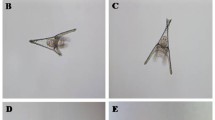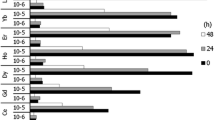Abstract
Early embryogenesis is one of the most sensitive and critical stages in animal development. Here we propose a new assessment model on the effect of pollutant to multicellular organism development. That is a comparison between the whole embryo assay and the blastomere culture assay. We examined the LiCl effect on the sea urchin early development in both of whole embryos and the culture of isolated blastomeres. The mesoderm and endoderm region were capable to differentiate into skeletogenic cells when they were isolated at 60-cell stage and cultured in vitro. The embryo developed to exogastrula by the vegetalizing effect of the same LiCl condition where ectodermal region changed their fate to endoderm, while the isolated blastomeres from the presumptive ectoderm region differentiated into skeletogenic cells in the culture with LiCl. The effect of LiCl to the sea urchin embryo and to the dissociated blastomere is a unique example where same cells response distinctly to the same agent depend on the condition around them. Present results show the importance of examining the process in cellular and tissue levels for the exact understanding on the morphological effect of chemicals and metals.




Similar content being viewed by others
Explore related subjects
Discover the latest articles and news from researchers in related subjects, suggested using machine learning.References
Aral H, Vecchio-Sadus A (2008) Toxicity of lithium to humans and the environment–a literature review. Ecotoxicol Environ Saf 70:349–356. doi:10.1016/j.ecoenv.2008.02.026
Duboc V, Röttinger E, Besnardeau L, Lepage T (2004) Nodal and BMP2/4 signaling organizes the oral-aboral axis of the sea urchin embryo. Dev Cell 6:397–410. doi:10.1016/S1534-5807(04)00056-5
Ettensohn CA, McClay DR (1988) Cell lineage conversion in the sea urchin embryo. Dev Biol 125:396–409
Ettensohn CA, Kitazawa C, Cheers MS, Leonard JD, Sharma T (2007) Gene regulatory networks and developmental plasticity in the early sea urchin embryo: alternative deployment of the skeletogenic gene regulatory network. Development 134:3077–3087. doi:10.1242/dev.009092
Fernández N, Cesar A, Salamanca MJ, DelValls TA (2006) Toxicological characterisation of the aqueous soluble phase of the Prestige fuel-oil using the sea-urchin embryo bioassay. Ecotoxicology 15:593–599. doi:10.1007/s10646-006-0096-y
Fukushi T (1962) The fate of isolated blastoderm cells of sea urchin blastulae and gastrulae into the blastocoel. Bull Mar Biol Stat Asamushi 11:21–30
Hall TS (1942) The mode of action of lithium salts in amphibian development. J Exp Zool 89:1–30. doi:10.1002/jez.1400890102
Hamada M, Kiyomoto M (2003) Signals from primary mesenchyme cells regulate endoderm differentiation in the sea urchin embryo. Dev Growth Differ 45:339–350. doi:10.1046/j.1440-169X.2003.00702.x
Hardin JD, Cheng LY (1986) The mechanisms and mechanics of archenteron elongation during sea urchin gastrulation. Dev Biol 115:490–501. doi:10.1016/0012-1606(86)90269-1
Herbst C (1892) Experimentelle untersuchungen uber den einfluss der veranderten chemischen zusammensetzung des umgebenden MEDIUMS auf die entwicklung der tiere I. Teil. Versuche an seeigeleiern. Z Wiss Zool 55:446–518
Hörstadius S (1973) Experimental embryology of echinoderms. Oxford Univ Press, London
Kao KR, Masui Y, Elinson RP (1986) Lithium-induced respecification of pattern in Xenopus laevis embryos. Nature 322:371–373. doi:10.1038/322371a0
Khaner O, Wilt F (1990) The influence of cell interactions and tissue mass on differentiation of sea urchin mesomeres. Development 109:625–634
Khaner O, Wilt F (1991) Interactions of different vegetal cells with mesomeres during early stages of sea urchin development. Development 112:881–890
Kitamura K, Nishimura Y, Kubotera N, Higuchi Y, Yamaguchi M (2002) Transient activation of the micro1 homeobox gene family in the sea urchin (Hemicentrotus pulcherrimus) micromere. Dev Genes Evol 212:1–10. doi:10.1007/s00427-001-0202-3
Kiyomoto M, Tsukahara J (1991) Spicule formation-inducing substance in sea urchin embryo. Dev Growth Differ 33:443–450. doi:10.1111/j.1440-169X.1991.00443.x
Kiyomoto M, Kikuchi A, Unuma T, Yokota Y (2006) Effects of ethynylestradiol and bisphenol a on the development of sea urchin embryos and juveniles. Mar Biol 149:57–63. doi:10.1007/s00227-005-0208-x
Kiyomoto M, Kikuchi A, Morinaga S, Unuma T, Yokota Y (2008) Exogastrulation and interference with the expression of major yolk protein by estrogens administered to sea urchins. Cell Biol Toxicol 24:611–620. doi:10.1007/s10565-008-9073-y
Klein PS, Melton DA (1996) A molecular mechanism for the effect of lithium on development. Proc Natl Acad Sci USA 93:8455–8459
Kobayashi N (1991) Marine pollution bioassay by using sea urchin eggs in the Tanabe Bay, wakayama prefecture, Japan, 1970–1987. Mar Poll Bull 23:709–713. doi:10.1016/0025-326X(91)90765-K
Kobayashi N, Okamura H (2004) Effects of heavy metals on sea urchin embryo development 1. Tracing the cause by the effects. Chemosphere 55:1403–1412. doi:10.1016/j.chemosphere.2003.11.052
Kobayashi N, Okamura H (2005) Effects of heavy metals on sea urchin embryo development. Part 2. Interactive toxic effects of heavy metals in synthetic mine effluents. Chemosphere 61:1198–1203. doi:10.1016/j.chemosphere.2005.02.071
Kominami T, Takaichi M (1998) Unequal divisions at the third cleavage increase the number of primary mesenchyme cells in sea urchin embryos. Dev Growth Differ 40:545–553. doi:10.1046/j.1440-169X.1998.t01-3-00009.x
Komukai M, Iizuka Y, Yasumasu I (1989) Synthesis of protein enriched in Li +-induced vegetalized embryos of sea urchin during early development. Dev Growth Differ 31:371–378. doi:10.1111/j.1440-169X.1989.00371.x
Kszos LA, Stewart AJ (2003) Review of Lithium in the aquatic environment: distribution in the United States, toxicity and case example of groundwater contamination. Ecotoxicology 12:439–447. doi:10.1023/A:1026112507664
Livingston BT, Wilt FH (1989) Lithium evokes expression of vegetal-specific molecules in the animal blastomeres of sea urchin embryos. Proc Natl Acad Sci U S A 86:3669–3673
Livingston BT, Wilt FH (1990) Range and stability of cell fate determination in isolated sea urchin blastomeres. Development 108:403–410
Logan CY, Miller JR, Ferkowiez MJ, McClay DR (1999) Nuclear beta-catenin is required to specify vegetal cell fates in the sea urchin embryo. Development 126:345–357
Mwatibo JM, Green JD (1998) Estradiol disrupts sea urchin embryogenesis differently from methoxychlor. Bull Environ Contam Toxicol 61:577–582
Nocente-McGrath C, McIsaac R, Ernst SG (1991) Altered cell fate in LiCl-treated sea urchin embryos. Dev Biol 147:445–450. doi:10.1016/0012-1606(91)90302-J
Okazaki K (1975) Spicule formation by isolated micromeres of the sea urchin embryo. Am Zool 15:567–581
Oliveri P, Carrick DM, Davidson EH (2002) A regulatory gene network that directs micromere specification in the sea urchin embryo. Dev Biol 246:209–228. doi:10.1006/dbio.2002.0627
Oliveri P, Davidson EH, McClay DR (2003) Activation of pmar1 controls specification of micromeres in the sea urchin embryo. Dev Biol 258:32–43. doi:10.1016/S0012-1606(03)00108-8
Phiel CJ, Klein PS (2001) Molecular targets of lithium action. Annu Rev Pharmacol Toxicol 41:789–813. doi:10.1146/annurev.pharmtox.41.1.789
Pillai MC, Vines CA, Wikramanayake AH, Cherr GN (2003) Polycyclic aromatic hydrocarbons disrupt axial development in sea urchin embryos through a b-catenin dependent pathway. Toxicology 186:93–108. doi:10.1016/S0300-483X(02)00695-9
Pinsino A, Matranga V, Trinchella F, Roccheri MC (2009) Sea urchin embryos as an in vivo model for the assessment of manganese toxicity: developmental and stress response effects. Ecotoxicology (in press). doi:10.1007/s10646-009-0432-0
Revilla-i-Domingo R, Oliveri P, Davidson EH (2007) A missing link in the sea urchin embryo gene regulatory network: hesC and the double-negative specification of micromeres. Proc Natl Acad Sci USA 104:12383–12388. doi:10.1073/pnas.0705324104
Salamanca MJ, Fernández N, Cesar A, Antón R, Lopez P, Delvalls A (2009) Improved sea-urchin embryo bioassay for in situ evaluation of dredged material. Ecotoxicology 18:1051–1057. doi:10.1007/s10646-009-0378-2
Shimizu K, Noro N, Matsuda R (1988) Micromere differentiation in the sea urchin embryo: expression of primary mesenchyme cell specific antigen during development. Dev Growth Differ 30:35–47. doi:10.1111/j.1440-169X.1988.00035.x
Shimizu-Nishikawa K, Katow H, Matsuda R (1990) Micromere differentiation in the sea urchin embryo; immunochemical characterization of primary mesenchyme cell-specific antigen and its biological roles. Dev Growth Differ 32:629–636. doi:10.1111/j.1440-169X.1990.00629.x
Stachel SE, Grunwald DJ, Myers PZ (1993) Lithium perturbation and goosecoid expression identify a dorsal specification pathway in the pregastrula zebrafish. Development 117:1261–1274
Stephens L, Kitajima T, Wilt F (1989) Autonomous expression of tissue-specific genes in dissociated sea urchin embryos. Development 107:299–307
Sweet HC, Gehring M, Ettensohn CA (2002) LvDelta is a mesoderm-inducing signal in the sea urchin embryo and can endow blastomeres with organizer-like properties. Development 129:1945–1955
Sweet H, Amemiya S, Ransick A, Minokawa T, McClay DR, Wikramanayake A, Kuraishi R, Kiyomoto M, Nishida H, Henry J (2004) Blastomere isolation and transplantation. Methods Cell Biol 74:243–271
Wikramanayake AH, Huang L, Klein WH (1998) Catenin is essential for patterning the maternally specified animal-vegetal axi in the sea urchin embryo. Proc Natl Acad Sci USA 95:9343–9348
Acknowledgments
We thank Mr Mamoru Yamaguchi (Tateyama Marine Laboratory, Marine and Coastal Research Center, Ochanomizu University) for the animal collections and Dr Hideki Katow (Tohoku University) for providing PMC-specific antibody.
Author information
Authors and Affiliations
Corresponding author
Rights and permissions
About this article
Cite this article
Kiyomoto, M., Morinaga, S. & Ooi, N. Distinct embryotoxic effects of lithium appeared in a new assessment model of the sea urchin: the whole embryo assay and the blastomere culture assay. Ecotoxicology 19, 563–570 (2010). https://doi.org/10.1007/s10646-009-0452-9
Accepted:
Published:
Issue Date:
DOI: https://doi.org/10.1007/s10646-009-0452-9




